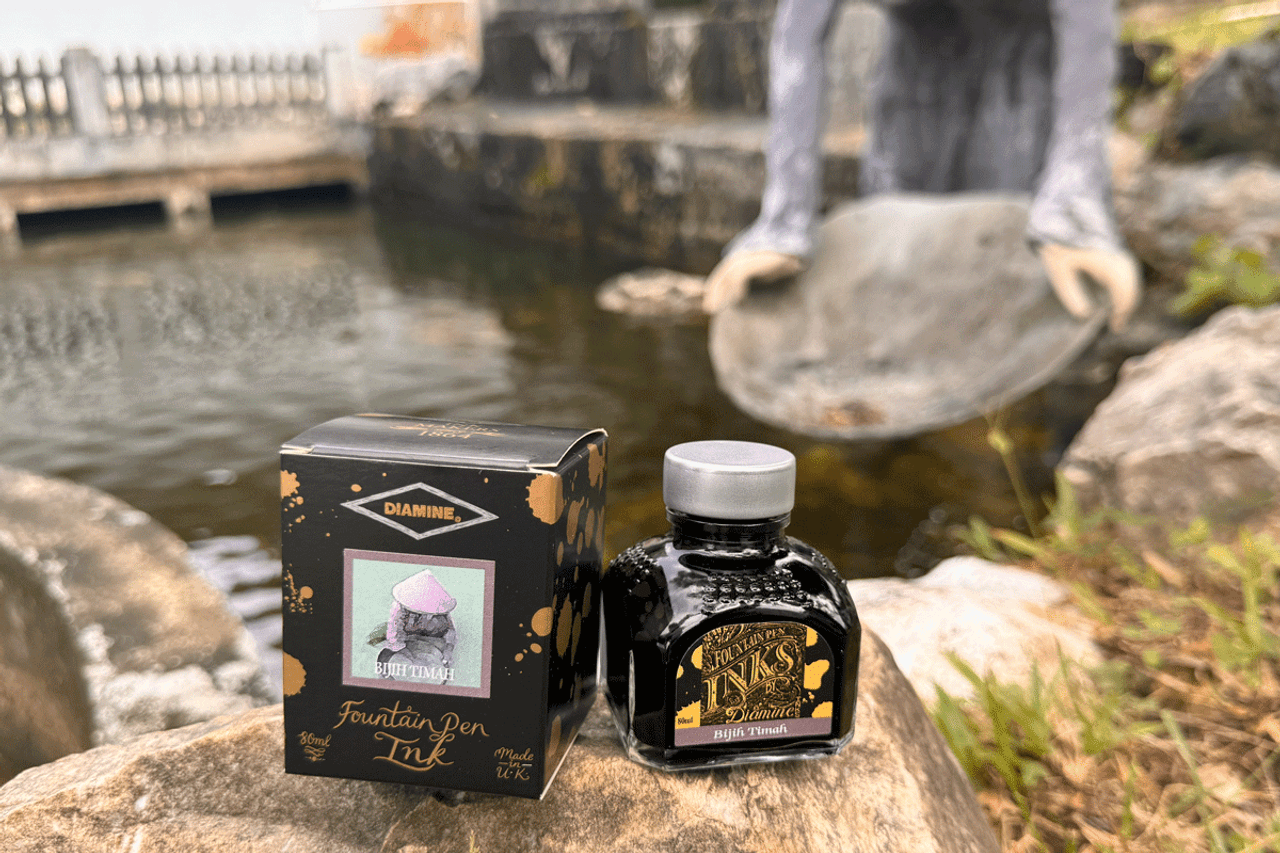Product Description
We are proud to present to you our 5th special collaboration between PenGallery and Diamine UK.
Diamine – Bijih Timah
A story about tin ore and its mining in Malaysia
Tin ore, is valued for its versatility, forming essential components in electronics, packaging, and alloys like bronze. Its low melting point enhances energy efficiency, while non-toxicity makes it safe for food-related applications. Highly recyclable and corrosion-resistant, the value of tin grew significantly in the 20th century as it contributed to sustainable practices and economic growth.
Tin mining in Malaysia peaked from the 1850s to 1980s, significantly impacting economic growth and attracting numerous immigrants. It played a significant role in the development of Malaya, and subsequently, Malaysia, particularly during the 19th and early 20th centuries. The discovery of rich tin deposits in states like Perak and Selangor attracted a wave of immigrants, especially from China and India with the former being the majority of the workforce in the tin mines and the latter playing crucial support roles. These groups brought expertise and techniques that were crucial to the industry and worked hand in hand with the Malay landowners to bring success to one another. The coming together of these three communities were integral to the development of the industry and significantly influenced the cultural and economic landscape of the country. Furthermore, the influx of these workers led to the emergence of vibrant communities, enriching Malaysian culture with diverse customs and traditions. The activities of tin mining also sparked the convergence of related businesses which subsequently led to the founding of major Malaysian cities such as Ipoh and Kuala Lumpur.
However, and inevitably, tin mining wealth in Malaysia also created economic disparities and harsh working conditions, leading to tensions among local communities and the authorities, and often sparking conflicts, leading to Malaya’s colonisation by the British and gaining her independence in 1957. Nevertheless, the legacy of tin mining and its impact on the Malay, Chinese and Indian communities remain an integral part of Malaysia's historical tapestry, reflecting both economic progress and complex social dynamics. It is with this intriguing backdrop that PenGallery has chosen the next ink in its Heritage series (following the Kopi O Kaw) to honour the impact of the tin ore with the Bijih Timah ink from Diamine.
The Diamine – Bijih Timah ink, is primarily a grey ink. When applied, the ink slowly reveals a subtle tinge of green that gracefully fades, eventually transforming into a refined blend of grey with hints of blue. The Bijih Timah has been produced exclusively for PenGallery by Diamine. Ink manufacturers since 1864, Diamine Inks proudly produces their inks using traditional methods in Liverpool, England. The very fine and consistently high quality of Diamine fountain pen inks make them suitable for all brands of fountain pens.
马来西亚的锡矿业在19世纪50年代至20世纪80年代达到顶峰,对经济增长产生了重大影响,并吸引了大量移民。它在马来亚的发展,以及随后的马来西亚,特别是在19世纪和20世纪初期,发挥了重要作用。在像霹雳州和雪兰莪州这样发现了丰富锡矿床的地方,吸引了一批移民,特别是来自中国和印度的移民,其中以前者为锡矿的主要劳动力,而后者则发挥着关键的支持作用。这些群体带来了至关重要的专业知识和技术,对该行业的发展起到了关键作用,并与马来地主携手合作,共同取得了成功。这三个社群的团结对行业的发展至关重要,并对该国的文化和经济格局产生了重大影响。此外,这些工人的涌入也导致了充满活力的社区的出现,丰富了马来西亚文化,充满了多样化的习俗和传统。锡矿业活动也引发了相关企业的汇聚,随后导致了大马主要城市如怡保和吉隆坡的建立。
然而,锡矿业在马来西亚带来的财富也不可避免地造成了经济上的差距和严苛的工作条件,导致了当地社区和当局之间的紧张关系,并经常引发冲突,最终导致了马来亚被英国殖民统治,并于1957年获得了独立。尽管如此,锡矿业的遗产及其对马来、华人和印度社群的影响仍然是马来西亚历史的重要组成部分,反映了经济进步和复杂的社会动态。正是在这个引人入胜的背景下,PenGallery选择了其传统系列中的下一款墨水(继Kopi O Kaw之后),以此来表彰锡矿石的影响,该墨水是由Diamine生产的Bijih Timah墨水。
Product Videos
Videos Hide Videos Show Videos
Custom Field
Product Reviews
1 Review Hide Reviews Show Reviews
-
Diamine ink
Great ink and great, fast service and delivery




























